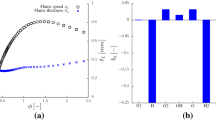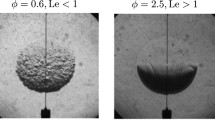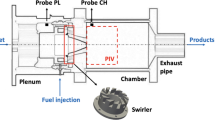Abstract
As a zero-carbon fuel, hydrogen is considered a promising alternative fuel. Hydrogen flames can be greatly affected by intrinsic instabilities including the diffusional-thermal instability (DTI) and Darrieus-Landau instability (DLI). Therefore, it is important to understand their properties, especially for cryogenic flames that are related to the safe utilization of liquid hydrogen. In this work, we conduct two-dimensional simulations of unsteady hydrogen/air conical flames to assess the effects of intrinsic instabilities, DTI and DLI, on the response of premixed hydrogen/air conical flames to inlet flow perturbations. The equivalence ratio and initial temperature are changed to respectively achieve different Lewis numbers (related to DTI) and expansion ratios (related to DLI). It is found that under certain conditions flame pinch-off occurs, during which a separated flame pocket is formed by the strong amplification of flame wrinkles generated by the inlet flow perturbations. The underlying mechanism of flame pinch-off enhancement due to DTI and DLI is different. For fuel-lean hydrogen/air at normal temperature, the flame front wrinkling is enhanced by strong DTI and it is the stretch-chemistry interaction that leads to flame pinch-off. However, for stoichiometric hydrogen/air at cryogenic temperature, there is a strong effect of DLI and flame pinch-off is mainly induced by flame-flow interaction. Moreover, downstream flow and flame speed near the separated flame pocket for flames exhibiting strong DTI and DLI are compared and the difference is analyzed. The findings indicate that intrinsic flame instability can amplify flame wrinkling and fluctuations in heat release rate, thereby contributing to flame pinch-off.
















Similar content being viewed by others
References
Abdin, Z., Zafaranloo, A., Rafiee, A., Mérida, W., Lipiński, W., Khalilpour, K.R.: Hydrogen as an energy vector. Renew. Sustain. Energy Rev. 120, 109620 (2020). https://doi.org/10.1016/j.rser.2019.109620
Ahn, M., Lim, D., Kim, T., Yoon, Y.: Pinch-off process of Burke-Schumann flame under acoustic excitation. Combust. Flame 231, 111478 (2021). https://doi.org/10.1016/j.combustflame.2021.111478
Aziz, M.: Liquid hydrogen: a review on liquefaction, storage, transportation, and safety. Energies 14, 5917 (2021). https://doi.org/10.3390/en14185917
Bariki, C., Halter, F., Thiesset, F., Chauveau, C., Gökalp, I., Teav, K., Kheirkhah, S., Steinberg, A.M.: Structural response of different Lewis number premixed flames interacting with a toroidal vortex. Proc. Combust. Inst. 37, 1911–1918 (2019). https://doi.org/10.1016/j.proci.2018.06.114
Bell, J.B., Cheng, R.K., Day, M.S., Shepherd, I.G.: Numerical simulation of Lewis number effects on lean premixed turbulent flames. Proc. Combust. Inst. 31, 1309–1317 (2007). https://doi.org/10.1016/j.proci.2006.07.216
Berger, L., Attili, A., Pitsch, H.: Intrinsic instabilities in premixed hydrogen flames: parametric variation of pressure, equivalence ratio, and temperature. Part 2—Non-linear regime and flame speed enhancement. Combust. Flame 240, 111936 (2022). https://doi.org/10.1016/j.combustflame.2021.111936
Berger, L., Grinberg, M., Jürgens, B., Lapenna, P.E., Creta, F., Attili, A., Pitsch, H.: Flame fingers and interactions of hydrodynamic and thermodiffusive instabilities in laminar lean hydrogen flames. Proc. Combust. Inst. 39, 1525–1534 (2023). https://doi.org/10.1016/j.proci.2022.07.010
Chen, C.L., Sohrab, S.H.: Upstream interactions between planar symmetric laminar methane premixed flames. Combust. Flame 101, 360–370 (1995). https://doi.org/10.1016/0010-2180(94)00214-D
Chen, J.H., Echekki, T., Kollmann, W.: The mechanism of two-dimensional pocket formation in lean premixed methane-air flames with implications to turbulent combustion. Combust. Flame 116, 15–48 (1999). https://doi.org/10.1016/S0010-2180(98)00026-1
Chen, X., Böttler, H., Scholtissek, A., Hasse, C., Chen, Z.: Effects of stretch-chemistry interaction on chemical pathways for strained and curved hydrogen/air premixed flames. Combust. Flame 232, 111532 (2021). https://doi.org/10.1016/j.combustflame.2021.111532
Cuquel, A., Durox, D., Schuller, T.: Impact of flame base dynamics on the non-linear frequency response of conical flames. C. r. Méc. 341, 171–180 (2013a). https://doi.org/10.1016/j.crme.2012.11.004
Cuquel, A., Durox, D., Schuller, T.: Scaling the flame transfer function of confined premixed conical flames. Proc. Combust. Inst. 34, 1007–1014 (2013b). https://doi.org/10.1016/j.proci.2012.06.056
Dave, H.L., Chaudhuri, S.: Evolution of local flame displacement speeds in turbulence. J. Fluid Mech. 884, A46 (2020). https://doi.org/10.1017/jfm.2019.896
Dawood, F., Anda, M., Shafiullah, G.M.: Hydrogen production for energy: an overview. Int. J. Hydrog. Energy 45, 3847–3869 (2020). https://doi.org/10.1016/j.ijhydene.2019.12.059
Ducruix, S., Durox, D., Candel, S.: Theoretical and experimental determinations of the transfer function of a laminar premixed flame. Proc. Combust. Inst. 28, 765–773 (2000). https://doi.org/10.1016/S0082-0784(00)80279-9
Echekki, T., Chen, J.H.: Analysis of the contribution of curvature to premixed flame propagation. Combust. Flame 118, 308–311 (1999). https://doi.org/10.1016/S0010-2180(99)00006-1
Fleifil, M., Annaswamy, A.M., Ghoneim, Z.A., Ghoniem, A.F.: Response of a laminar premixed flame to flow oscillations: a kinematic model and thermoacoustic instability results. Combust. Flame 106, 487–510 (1996). https://doi.org/10.1016/0010-2180(96)00049-1
Ghosh, A., Munoz-Munoz, N.M., Chatelain, K.P., Lacoste, D.A.: Laminar burning velocity of hydrogen, methane, ethane, ethylene, and propane flames at near-cryogenic temperatures. Appl. Energy Combust. Sci. 12, 100094 (2022). https://doi.org/10.1016/j.jaecs.2022.100094
Goodwin, D.G., Speth, R.L., Moffat, H.K., Weber, B.W.: Cantera: an object-oriented software toolkit for chemical kinetics, thermodynamics, and transport processes (2018). https://doi.org/10.5281/zenodo.1174508
Huo, J., Saha, A., Ren, Z., Law, C.K.: Self-acceleration and global pulsation in hydrodynamically unstable expanding laminar flames. Combust. Flame 194, 419–425 (2018). https://doi.org/10.1016/j.combustflame.2018.05.025
Kerstein, A.R., Ashurst, W.T., Williams, F.A.: Field equation for interface propagation in an unsteady homogeneous flow field. Phys. Rev. A 37, 2728–2731 (1988). https://doi.org/10.1103/PhysRevA.37.2728
Kim, T., Ahn, M., Hwang, J., Kim, S., Yoon, Y.: The experimental investigation on the response of the Burke-Schumann flame to acoustic excitation. Proc. Combust. Inst. 36, 1629–1636 (2017). https://doi.org/10.1016/j.proci.2016.06.116
Konnov, A.A.: Yet another kinetic mechanism for hydrogen combustion. Combust. Flame 203, 14–22 (2019). https://doi.org/10.1016/j.combustflame.2019.01.032
Kuznetsov, M., Denkevits, A., Veser, A., Friedrich, A.: Flame propagation regimes and critical conditions for flame acceleration and detonation transition for hydrogen-air mixtures at cryogenic temperatures. Int. J. Hydrog. Energy 47, 30743–30756 (2022). https://doi.org/10.1016/j.ijhydene.2022.07.024
Landau, L.: On the theory of slow combustion. In: Dynamics of Curved Fronts, pp. 403–411. Elsevier (1988)
Law, C.K.: Combustion Physics. Cambridge University Press, Cambridge (2006)
Liberman, M.A.: Combustion Physics: Flames, Detonations, Explosions, Astrophysical Combustion and Inertial Confinement Fusion. Springer International Publishing, Cham (2021)
Lieuwen, T.: Modeling premixed combustion-acoustic wave interactions: a review. J. Propuls. Power. 19, 765–781 (2003). https://doi.org/10.2514/2.6193
Magina, N., Acharya, V., Lieuwen, T.: Forced response of laminar non-premixed jet flames. Prog. Energy Combust. Sci. 70, 89–118 (2019). https://doi.org/10.1016/j.pecs.2018.08.001
Magina, N., Acharya, V., Sun, T., Lieuwen, T.: Propagation, dissipation, and dispersion of disturbances on harmonically forced, non-premixed flames. Proc. Combust. Inst. 35, 1097–1105 (2015). https://doi.org/10.1016/j.proci.2014.07.050
Matalon, M.: Intrinsic flame instabilities in premixed and nonpremixed combustion. Annu. Rev. Fluid Mech. 39, 163–191 (2007). https://doi.org/10.1146/annurev.fluid.38.050304.092153
Nagel, W.E., Kröner, D.H., Resch, M.M. (eds): High Performance Computing in Science and Engineering ’14. Transactions of the High Performance Computing Center, Stuttgart (HLRS) 2014. Springer International Publishing, Cham (2015)
Peters, N.: Turbulent Combustion. Cambridge University Press, Cambridge (2000)
Poinsot, T.: Prediction and control of combustion instabilities in real engines. Proc. Combust. Inst. 36, 1–28 (2017). https://doi.org/10.1016/j.proci.2016.05.007
Poinsot, T., Veynante, D.: Theoretical and Numerical Combustion. Rtedwards Inc. (2005)
Preetham, Santosh, H., Lieuwen, T.: Dynamics of laminar premixed flames forced by harmonic velocity disturbances. J. Propuls. Power 24, 1390–1402 (2008). https://doi.org/10.2514/1.35432
Preetham, Thumuluru, S.K., Santosh, H., Lieuwen, T.: Linear response of laminar premixed flames to flow oscillations: unsteady stretch effects. J. Propuls. Power 26, 524–532 (2010). https://doi.org/10.2514/1.41559
Schlimpert, S., Hemchandra, S., Meinke, M., Schröder, W.: Hydrodynamic instability and shear layer effect on the response of an acoustically excited laminar premixed flame. Combust. Flame 162, 345–367 (2015). https://doi.org/10.1016/j.combustflame.2014.08.001
Schlimpert, S., Meinke, M., Schröder, W.: Nonlinear analysis of an acoustically excited laminar premixed flame. Combust. Flame 163, 337–357 (2016). https://doi.org/10.1016/j.combustflame.2015.09.035
Schuller, T., Durox, D., Candel, S.: A unified model for the prediction of laminar flame transfer functions. Combust. Flame 134, 21–34 (2003). https://doi.org/10.1016/S0010-2180(03)00042-7
Shreekrishna, Hemchandra, S., Lieuwen, T.: Premixed flame response to equivalence ratio perturbations. Combust. Theory Model. 14, 681–714 (2010). https://doi.org/10.1080/13647830.2010.502247
Sinigaglia, T., Lewiski, F., Santos Martins, M.E., Mairesse Siluk, J.C.: Production, storage, fuel stations of hydrogen and its utilization in automotive applications-a review. Int. J. Hydrog. Energy 42, 24597–24611 (2017). https://doi.org/10.1016/j.ijhydene.2017.08.063
Talei, M., Hawkes, E.R., Brear, M.J.: A direct numerical simulation study of frequency and Lewis number effects on sound generation by two-dimensional forced laminar premixed flames. Proc. Combust. Inst. 34, 1093–1100 (2013). https://doi.org/10.1016/j.proci.2012.07.034
Troiani, G., Lapenna, P.E., Lamioni, R., Creta, F.: Self-wrinkling induced by Darrieus-Landau instability in turbulent premixed Bunsen flames from low to moderately high Reynolds numbers. Phys. Rev. Fluids 7, 053202 (2022). https://doi.org/10.1103/PhysRevFluids.7.053202
Tyagi, A., Boxx, I., Peluso, S., O’Connor, J.: Pocket formation and behavior in turbulent premixed flames. Combust. Flame 211, 312–324 (2020). https://doi.org/10.1016/j.combustflame.2019.09.033
Wang, H.Y., Law, C.K., Lieuwen, T.: Linear response of stretch-affected premixed flames to flow oscillations. Combust. Flame 156, 889–895 (2009). https://doi.org/10.1016/j.combustflame.2009.01.012
Verfondern, K., Cirrone, D., Molkov, V., Makarov, D., Coldrick, S., Ren, Z., Wen, J., Proust, C., Friedrich, A., Jordan, T., Kuznetsov, M.: Handbook of Hydrogen Safety: Chapter on LH2 Safety. Pre-normative Research for Safe use of Liquid Hydrogen (PRESLHY) (2021)
Wang, Y., Han, W., Zirwes, T., Zhang, F., Bockhorn, H., Chen, Z.: Effects of low-temperature chemical reactions on ignition kernel development and flame propagation in a DME-air mixing layer. Proc. Combust. Inst. 39, 1515–1524 (2023). https://doi.org/10.1016/j.proci.2022.07.024
Wang, Y., Zhang, H., Zirwes, T., Zhang, F., Bockhorn, H., Chen, Z.: Ignition of dimethyl ether/air mixtures by hot particles: Impact of low temperature chemical reactions. Proc. Combust. Inst. 38, 2459–2466 (2021). https://doi.org/10.1016/j.proci.2020.06.254
Weller, H.G., Tabor, G., Jasak, H., Fureby, C.: A tensorial approach to computational continuum mechanics using object-oriented techniques. Comput. Phys. 12, 620–631 (1998). https://doi.org/10.1063/1.168744
Wen, X., Zirwes, T., Scholtissek, A., Böttler, H., Zhang, F., Bockhorn, H., Hasse, C.: Flame structure analysis and composition space modeling of thermodiffusively unstable premixed hydrogen flames—Part I: atmospheric pressure. Combust. Flame 238, 111815 (2022a). https://doi.org/10.1016/j.combustflame.2021.111815
Wen, X., Zirwes, T., Scholtissek, A., Böttler, H., Zhang, F., Bockhorn, H., Hasse, C.: Flame structure analysis and composition space modeling of thermodiffusively unstable premixed hydrogen flames—Part II: elevated pressure. Combust. Flame 238, 111808 (2022b). https://doi.org/10.1016/j.combustflame.2021.111808
Xia, X., Zhang, P.: A vortex-dynamical scaling theory for flickering buoyant diffusion flames. J. Fluid Mech. 855, 1156–1169 (2018). https://doi.org/10.1017/jfm.2018.707
Xie, S., Chen, X., Böttler, H., Scholtissek, A., Hasse, C., Chen, Z.: Forced ignition of a rich hydrogen/air mixture in a laminar counterflow: a computational study. Flow Turbul. Combust. 110, 441–456 (2023). https://doi.org/10.1007/s10494-022-00374-2
Yang, L., Chen, Z.: Effects of cryogenic temperature on premixed hydrogen/air flame propagation in a closed channel. Proc. Combust. Inst. 39, 2991–2999 (2023). https://doi.org/10.1016/j.proci.2022.08.091
Zhang, F., Zirwes, T., Habisreuther, P., Bockhorn, H.: Effect of unsteady stretching on the flame local dynamics. Combust. Flame 175, 170–179 (2017). https://doi.org/10.1016/j.combustflame.2016.05.028
Zhang, F., Zirwes, T., Wang, Y., Chen, Z., Bockhorn, H., Trimis, D., Stapf, D.: Dynamics of premixed hydrogen/air flames in unsteady flow. Phys. Fluids 34, 085121 (2022). https://doi.org/10.1063/5.0098883
Zirwes, T., Sontheimer, M., Zhang, F., Abdelsamie, A., Pérez, F.E.H., Stein, O.T., Im, H.G., Kronenburg, A., Bockhorn, H.: Assessment of numerical accuracy and parallel performance of OpenFOAM and its reacting flow extension EBIdnsFoam. Flow Turbul. Combust. 111, 567–602 (2023a). https://doi.org/10.1007/s10494-023-00449-8
Zirwes, T., Zhang, F., Bockhorn, H.: Memory effects of local flame dynamics in turbulent premixed flames. Proc. Combust. Inst. 39, 2349–2358 (2023b). https://doi.org/10.1016/j.proci.2022.07.187
Zirwes, T., Zhang, F., Habisreuther, P., Hansinger, M., Bockhorn, H., Pfitzner, M., Trimis, D.: Quasi-DNS dataset of a piloted flame with inhomogeneous inlet conditions. Flow Turbul. Combust. 104, 997–1027 (2020). https://doi.org/10.1007/s10494-019-00081-5
Zirwes, T., Zhang, F., Wang, Y., Habisreuther, P., Denev, J.A., Chen, Z., Bockhorn, H., Trimis, D.: In-situ flame particle tracking based on barycentric coordinates for studying local flame dynamics in pulsating Bunsen flames. Proc. Combust. Inst. 38, 2057–2066 (2021). https://doi.org/10.1016/j.proci.2020.07.033
Acknowledgements
We thank Professor Dong Yang at Southern University of Science and Technology for helpful discussion. The simulations were conducted on the Tianhe-2A supercomputer in Guangzhou, China.
Funding
This research was funded by NSFC, China (Nos. 52176096), the Space Application System of China Manned Space Program, and the Fundamental Research Funds for the Central Universities, Peking University.
Author information
Authors and Affiliations
Contributions
LY and ZC conceived and planned the simulations. LY conducted simulations and analysis, prepared the figures and wrote the original draft. LY analyzed the data. YW and TZ; assisted in further analysis. ZC supervised the project. All authors discussed the results and reviewed the manuscript.
Corresponding author
Ethics declarations
Conflict of interest
The authors have no relevant financial or non-financial interests to disclose.
Additional information
Publisher's Note
Springer Nature remains neutral with regard to jurisdictional claims in published maps and institutional affiliations.
Rights and permissions
Springer Nature or its licensor (e.g. a society or other partner) holds exclusive rights to this article under a publishing agreement with the author(s) or other rightsholder(s); author self-archiving of the accepted manuscript version of this article is solely governed by the terms of such publishing agreement and applicable law.
About this article
Cite this article
Yang, L., Wang, Y., Zirwes, T. et al. Effects of Intrinsic Instabilities on the Response of Premixed Hydrogen/Air Conical Flames to Inlet Flow Perturbations. Flow Turbulence Combust 112, 1275–1297 (2024). https://doi.org/10.1007/s10494-024-00535-5
Received:
Accepted:
Published:
Issue Date:
DOI: https://doi.org/10.1007/s10494-024-00535-5




